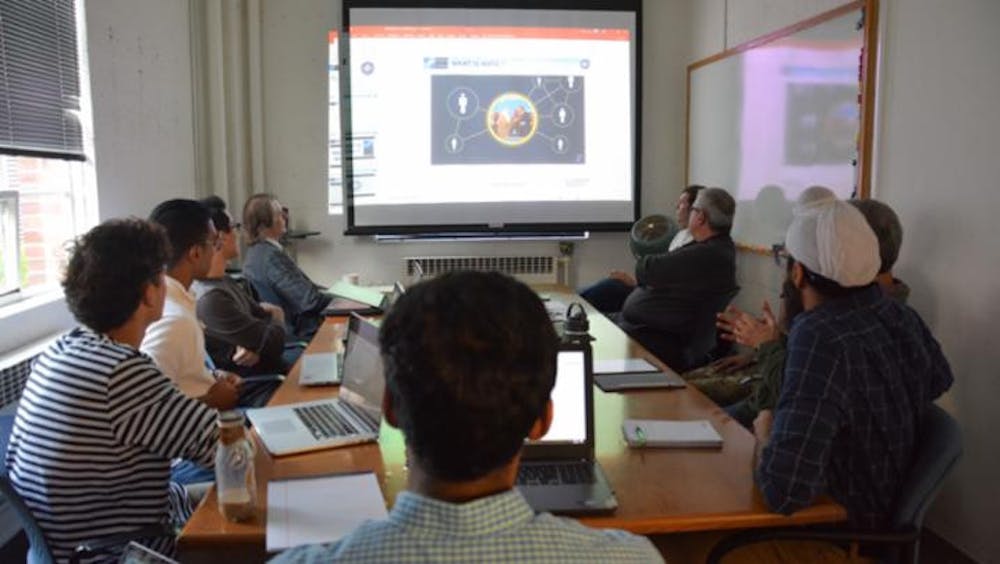A team of six Hopkins undergraduates partnered with the North Atlantic Treaty Organization (NATO) to devise a system that improves current combat-triage techniques in an effort to save soldiers’ lives and revolutionize the way the medical community addresses mass casualty events.
Seniors David Calvo, Jonathan Edwards, Sean Glaister, Angelino Go, Vara Mathiyalakan and Bella Ferrara came together to create the Digital Triage Assistant (DTA) almost two years ago. The six students are part of the A. James Clark Scholars Program, an academic program designed by the School of Engineering and the A. James & Alice B. Clark Foundation to promote the development of future engineers. The students were approached by NATO in one of their Clark Engineering Design Challenge courses to address a prevalent issue: the high incidence of frontline casualties.
In an email to The News-Letter, Calvo explained that the team created mind maps and solution slides in an attempt to narrow the huge problem down to a small concise one. One of the ideas that was pitched during this process was the DTA, an artificial intelligence system that automates the triage process, enabling combat medics to redirect their limited time from assessing injuries to the treatment of soldiers.
Go described the professional consultation the group received in an interview with The News-Letter.
“We talked to a lot of experts like different military generals, medics, doctors and surgeons to get their opinion on the viability of different products and issues on the frontline that need addressing more specifically,” Go said.
One particularly influential expert was Dr. Ariel Furer, former Chief Innovation Officer for the Israel Defense Forces Medical Corps. According to Glaister, Furer believed future warfare will involve collecting vital health data on soldiers to predict the deterioration of their health and create a more efficient medical response. This was one of the foundational principles of the model the team created.
“Ideally, the model would be very data-driven... It would collect a lot of data for a population of people that are disproportionately getting hurt, so you would have a lot of data on when people get hurt, what vitals they had and what that leads to,” Glaister said. “That can help inform a lot of medical predictions.”
According to Calvo, these predictions and data can improve the treatment process by conserving valuable resources and improving the process by which physicians treat patients during combat or in civilian mass casualty events. The DTA helps medics triage patients by continuously monitoring a soldier’s vitals and transmitting this information to a centralized location for the medic. Calvo explained that the DTA also calculates an injury severity score based on the vitals it is monitoring.
In an interview with The News-Letter, Mathiyalakan talked about the goals of the DTA.
“The main goal is to get cardiac output, which is how much work your heart is doing. There’s different factors that go into that,” Mathiyalakan said.
The DTA measures heart rate, oxygen saturation and blood pressure. The team chose to monitor these vitals because these were the stats that were most commonly used in various triage systems.
“What’s cool about [the DTA] is that it’s taking almost a consensus approach to triage from drawing upon all the systems and then analyzing from a more data perspective rather than following specific steps, which makes it more analytical,” Mathiyalakan said.
The DTA conducts its analysis and computes a numerical output that indicates the degree of urgent treatment a soldier requires. Edwards explained that the output of the DTA is flexible. The numeric output that is calculated can be used by medics or it can also be bucketed into one of three levels — high, medium and low risk.
Calvo said the team found that medics preferred to have both the general score that was computed by the DTA as well as the specific vitals that were monitored. The three-tiered system made it easy for medics to decide which soldiers to direct their attention to. For the most injured soldiers, the medics found it useful to have that soldier’s stats to determine a course of treatment.
Edwards explained the value of the DTA is the structure it brings to the triage process, so people in need of emergency help are identified and medics can disperse resources more efficiently.
The team partnered with Czech Technical University in Prague (CTU) to create a prototype wearable for their software. Calvo and Edwards worked with CTU’s computer science team to build an initial prototype, which involved sensors strapped to a soldier’s torso to monitor their vitals.
Calvo explained that the team has done as much as they can to contribute to the project. The Czech team is now continuing to develop the DTA. Around August 13, the Czech team tested the software and wearables in a simulation. They are currently collaborating with Garmin to create a watch that would replace the sensors on the soldier’s torso.
“They particularly like it for tracking training regiments to make sure they can catch [health conditions in their soldiers] during training before sending [them] out into the field,” Calvo said.
The team has created a great impact in the medical community with their development that extends past the DTA; Calvo mentioned the long-lasting relationships the team pioneered among a variety of universities across the globe will prove valuable for future collaborations.
“It’s been cool to see it evolve. It started on the seventh floor of Charles Commons eating [cookies from] Insomnia Cookies [and] just talking about ideas. Now when you see it, it’s almost surreal... It’s a cool experience,” Mathiyalakan said.

















